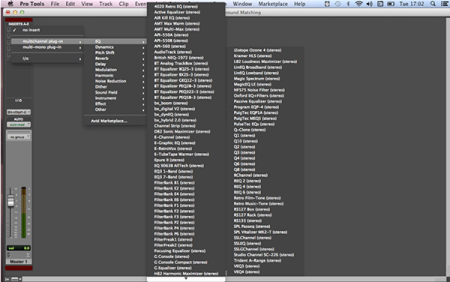Analogue vs Digital - a (user) Experience Perspective
Roey Izhaki octobre 2014
octobre 2014DOI : https://dx.doi.org/10.56698/rfim.373
Texte intégral
Introduction
1I’d like to speak about “analogue versus digital”.
2For a lot of people, when you speak about analogue versus digital, they think about sound, the sound of analogue versus the sound of digital. But I argue that it is often related to the experience that we have as we use analogue versus that when we use digital.
3I’d like to start asking few questions. I’ll show you few options on the board and I need you to choose just one of them.
Which one do you belong to?

The studio
4Suppose you have a plan for working in a studio. You have a choice to go to two studios. Do you prefer to go to studio 1 or to studio 2?

Plug-ins
5From the following plugins, imagine that at the end of today, you get one of them for free. I need you to choose the plug-in you want and to think about the time it took you to make a choice.
Choose between these plug-ins

Choose between these plug-ins

2. Personal background
2001
6In 2001, I was a songwriter and a (bad) multi-instrumentalist. I could play a bit of drums, a bit of bass, a bit of keyboard, a bit of guitar, a bit of trumpet and I had nearly ten years of experience in recording and mixing. A kind of luck, I think I was very comfortable with mixing. It was mixing exclusively “In-the-box”, that means using DAW, using computers. It was the beginning of working in full duplex mode, using audio cards for recording and playing sounds at the same time. Then I started a Recording Arts degree at SAE in London. The reason I did was because I simply wanted to record my own music and for it to sound better. I didn’t want to be a recording engineer, I didn’t want to be a mixing engineer, I just wanted to get better in music production.
2002
7In 2002, there was a very important moment of my life that happened in the SSL studio of the school where I studied.

SSL studio at SAE London
8The story goes like this: I just finished recording everything for the final project of my first year. The last thing that I recorded were violins. We had a Mackie HDR in the studio and we only had 24 tracks. Before recording the violins, I didn’t have enough tracks. I couldn’t bring a group of violinists. I had only one violinist and she played nine times the different parts. So I needed nine tracks but I didn’t have nine tracks. So I had to fold the drums to clear some tracks for the violins. When the violin session was over I saved the project but still had to fold the violins so to unfold the drums.
9It was 6 o’clock, I was about to leave the school but the studio was available until 10 o’clock the morning after so I taught it was fantastic – I can do some housekeeping. But as I began with the housekeeping tasks I began to do some mixing, with the faders, then eqs, then reverb, and quickly I was mixing full engines on. It became 10 o’clock, then midnight, then 6 in the morning. At 10 o’clock, when the other students came, I was actually quite upset. I really wanted more. I asked: “What is going on? Why am I upset? I’ve just being in the studio for sixteen hours straight”. At that moment I really understood that mixing is what I wanted to do. Not songwriting, playing instruments or recording. Mixing.
2004
10In 2004, I became a lecturer at the SAE in London.

2006
11In 2006, I joined the Audio Skeptics Society. It’s not a real society. I can give an example. When you mix for years, something that happened to me, you mix a song, you want the kick to be a little bit more clear on the beat. You open the EQ, you change a slider slightly, you listen and say: “that’s great”. Then you close the plug-in and you realize that actually the track you EQed is muted. That’s something that happens quite a lot. So this is a question, can I really hear the differences? Can I really hear the changes?

12That’s what I want to say about being “Audio Skeptic”. A lot of people say: “analog sounds so good, so much better than digital” and this ADC sounds better than this ADC. I just decided to not believe these people.
13I’ve to tell you an important story. I was part of a listening experiment when we were presented with two masters – both were done by a famous mastering engineer, one was done using expensive analogue gear, the other using Logic plugins only. You weren’t told which one is which and I was asked two questions:
-
first of all, can we tell him which one is analog and which one is digital?
-
which one do you prefer?
14There was tiny differences between them, but there was no way for me to say which one is analog, which one is digital. But I had to choose one so I choose the one that had perhaps a little more harmonics. The results of this experiments was practicality 50/50. Participants basically couldn’t tell which one is which. This was the beginning of the Audio Skeptics Society.
2007
15In 2007, I published a book about mixing, a project that started in 2004.

2009
16In 2009, during open days in the university, I was in the studio asking if anyone had any question and someone said: “OK, how relevant is it for students to study this big analog desk now when everyone is doing things in the box?” The answer gave was: “It is very important and the reason it is important is because the experience of working in such studio compared to the experience we have working in the box. It is very very different.” It is hard for me to explain to someone who doesn’t have any experience working in an analog studio – every time I go with students to do mixing sessions in an analogue studio, I leave with an amazing feeling. I’m working the box a lot of time but I don’t enjoy as much. The experience with the analog studio is important. The good things about the analog experience can be applied into the box in digital domain.

17But what really makes the experience of using analog equipment different from the experience of using digital or in the box or computers?
2013
18I decided to do a Master in HCD (Human Centred Design) aka UX (User eXperience), which is about understanding what happens in our head, understanding the way we behave, why we like things or not, how exactly our brain works, in order to build designs in the real world. How could we apply psychology to the audio domain?
19My interest in participating in this conference is because in London we have quite a few French students. If I could define French students, they have something special, in a sense they are very artistic. Most are also very philosophical. Everything they do comes with some deep thought. I believe they have something in their culture that deeply involves Art and Philosophy at a deeper level.
3. Design, the brain and psychology
20I want to give a definition to what mixing is. The best definition is probably “the art and science of sound design”. We are designing sounds. Unfortunately, sound design is something that is often reserved to people who are dealing with Max/MSP, PureData, Reaktor, Supercollider, etc. Sound Design can be the Design of Sonic Landscapes. What is important is that we are designers.
A good session
21What is a good session? We are focused on sound and music. Most of our attention goes to sounds, but most of our work that we do is goes towards manipulating sounds. Ideally we work fast, fast is good because you have more time to be creative. And it is easy.
Design and psychology
22“Satisficing” is a term used in Design, a combination of “satisfying” and “sufficing”. Complex problem have a multitude of interacting variables, the combination of which makes an optimal solution unlikely (if not impossible). When I was young, I wanted to create perfect mixes. I was a perfectionist. As I grew up, I realized there is no such thing as a perfect mix. The reason is that mixes are for people, for a multitude of people. People are subjective with their own history and experiences. There is no such thing, something everyone would like equally. This is interesting, so you cannot create something that is optimal. There is a multitude of interacting variables. We have a multitude of instruments. There is a term “a waterbed problem”. You make something louder but other things get quieter. You must try creating something that is satisfying.
Motivation
23The more urgent/small the task is, the more likely we are to perform it and the more likely we are to stay focused.
The Brain
24It can be compared to a massive computer. The fastest supercomputer that we have now will take forty minutes to perform the same operation our brain does every second. In five generations we will approach these performances. But the brain is a highly efficient machine but, most important, it is highly limited. Here is an example of a basic stuff that we cannot do Most people cannot remember more than five numbers by heart in the following series: 3.1415 926 535 8979 323 84.
25There is another thing that our brain can do. Imagine, if you watch at the same time two televisions, one is showing the BBC news, the other CNN news. Your brain can handle this. This is the cocktail effect, the brain has to focus on one and not the other, but if you focus on BBC, the other is just noise, a distraction, so you much better must switch the CNN off. It is much difficult to focus on one channel if you close your eyes.
26The next example is an Awareness Test that can be found on the Internet1 that show that “It’s easy to miss something that you’re not looking for”.
Constraint
27The next tip is about constraint. Constraint can be good, can be bad or can be neutral.
28Here is an example of a good constraint.

29The physical properties of an XLR cable mean that we can’t plug it into a main socket.
30Then there is an example of a bad constraint.

31We cannot bounce to a 32 bits float, if that’s what you want.
32The neutral constraints are the interesting one because it’s up to you to decide whether they are good or bad. I’ll give two examples.

33It is the Manley active-passive. It is an extremely common equalizing and mastering sweets. It cost 4600 euros. There is something a bit odd. The frequency pots or knobs are latched, they are not continuous. You can select some frequencies but you can’t choose between them.

34This tape machine has quite few constraints. The first one is that you can only record 24 tracks. The second one is that you cannot record takes like in Pro Tools. One of the interesting constraints of the tape machine (I never taught about that before students ask me about that) is that you have to wait when you rewind! So you can not do a continuous loop like on Protools. When you do a mix, you must play the whole piece, then do a break, and think about what you have to do (or smoke a cigarette).
Wayfinding
35How easily can we found what we are looking for?


36The idea is this: we found easier to recognize things. We recognize the image before looking at the labels.
Form Follows Function

37With the Iphone, from IOS6 to IOS7, they made the interface “cleaner”. Things must be first functional, and then they can look pretty. You must not sacrifice functionality for beauty. It is much easy to identify things with a simple form.
Choice
38The most important concept is the concept of “Choice”.
39The Hick’s Law, in design code, is an equation:

40How long does it take us to respond to something based on “n”, the number of options?
41For example, if you have two plugins over there, it is very easy to make a decision. But if you have eight plug-ins doing the thinks you want, it takes much longer to make a decision.
Cognitive Overload

42If there is too much to do, the brain stops making decisions. It becomes irrational, not calculated. If you can choose between 50 different red wine bottles, you can’t do a comparison bottle by bottle. It will take you months. Your decision can’t be the optimal one.
The Choice Paradox
43There are two topics that everyone is very excited about: happiness and choice! People think that the more choice that we have, the more freedom we have. What we know is that too much choice is actually very bad force.

44On the graph, “good” means that we are happy. “Bad” means it is very hard to make a decision and we may get depressed.
Senses

See 2
45The previous graph shows the amount of information that reach our brain every second when we are awake. The blue one is the visual, the widest information channel we have. The second one is the touch. The auditory and the smell are both in third position. Also the visual global information that we get is larger than all other senses combined. It is related to the processing power of the brain.
46I have a friend who has a PhD in psychology. I was asking the following question: “why is it when I shut my eyes (often when I listen music, I shut my eyes) I can hear better?”. The answer was that by all means, the information that reaches your brain is only for the auditory channel. There is not interfere between the visual and auditory channels.
47This explains the McGurk effect discovered in 1976. If you hear the sound of “ba” but you see on a screen someone saying “ga”, most people will perceive “da”. It shows that in our brain there is a link between the auditory parts and the visual parts.

“McGurk effect : auditory and visual speech information is presented separately” 3
4. Analogue vs Digital
Interface
48We have hands. This is typically how we manipulate stuff using analogue equipment. We touch that. There is direct manipulation. We move a fader and something is happening.
49On the following figure, there is a mouse. We can see the original one and a mouse we use today. This was a phenomenal invention. It can solve the problem we have to type things into keyboards. If you really think about it, it is a very bad invention. When you work with a DAW, everything you do has to go through this primitive device called the mouse.

Choices
50One problem that we have, in digital, is that we can record takes. In analogue, you do punch in punch out, when you record you erase the previous takes. If you have to compare the different takes you have made, it can take several hours.
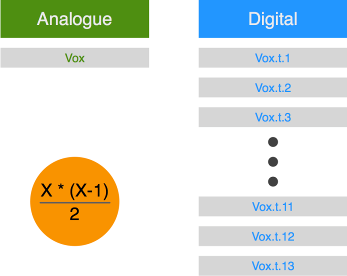
The number of comparison to do between takes
51There is another problem that we have in digital. We don’t have the limitation of 24 tracks anymore. We can record 70 tracks. We can record 4 kick tracks. The number of combinations reaches the number 2x. There is much more choice that we can have with digital compared to analogue. This is simple constraint: analogue reduces the amount of choices we have to make.

Goal
Solo the 4 overheads tracks
52If we want to solo tracks, for example the 4 overheads tracks. How do we do that with analogue? Click! How do we do that with digital? Click, move the mouse, click, move the mouse, click, move the mouse, click, move the mouse!
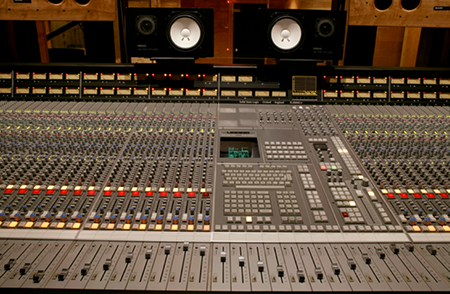
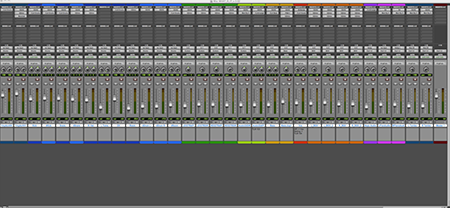
Interfaces for analogue (top) and digital (bottom) equipments
Add HF to the Kick Drum
53If you want to add high frequencies to the kick drum, you must find the kick track, choose an EQ and then twiddle gain and frequencies.
54To find the kick track on an analogue large and big desk, everything is in front of you. The only thing you have to do is to look where is the kick track. On a DAW, you have to scroll.
55Then choose an equalizer. If you are working with analogue, you can use board one, the SSL one, no choice. Even if you want to choose one, most of the time, you are looking at the rack. In the figure you can see seven choices.

56How do you choose equalizer in digital? The next figure shows the choices you have. In my high school, students can have a laptops. The figure is a screenshot of one of my student laptops two weeks after he got it. This is the list of the equalizers he has installed on the machine. Seriously, do you think this is good?
57So we have to click and then move, and then click and then move, and then click and then go down, and then scroll… With analogue, we just have to patch.
58For twiddle gain and frequency with analogue equipment, I can, with two hands, manage both at the same time. With digital, I have to take my mouse, then change the frequency, then go to the gain and change the gain, then go to the frequency and change the frequency. I always jump between gain and frequency.
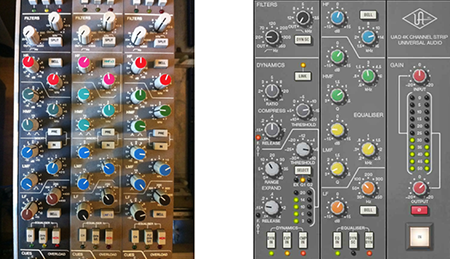
Form Follows Function
59Remember: form follows function. One of the big criticisms is that digital technology mimics the real world. I would prefer to control frequency on X-axis and gain on Y-axis with my mouse.
60Something maybe that is more important with equalizations, they come with visuals and we look at the visuals.
61I’ve a story about the equalizer on the left in the next figure. In the Mackie studio there was someone who was mixing something with this equalizer on the screen. And I saw a very large boost and asked him: “what need that much boost?”. He answered: “It’s for the sub!”. If you know some theory, sub bass is pure 40 or 50 Hz. There is absolutely nothing at these frequencies. The guy was just equalizing nothing. Often, people use visual information to make a decision, and maybe we should actually use our ears only instead. The other thing is that if our visual channel is occupied, the auditory one is less available. When I mix on an analogue desk, I don’t really look at the frequency, I don’t really look at the gain. I just change the values and listen the sound. This is a better way of working. Some people use frequency graph (next picture on the right) to decide how to equalize. But if it sounds good it must be good, you don’t need to look at a graph.
5. Recommendations
Put constraints
62The first recommendation is: put constraints on your job. Please understand that the amount of plug-ins that you have doesn’t matter. You won’t be better in mixing. You can just use for equalization the plug-in that comes with Protools (it’s what I do 95% of the time). They all do the same job.
Multi-touch
63Get something you can touch. Maybe the following device is very expensive. But you have solo and mute. When you mix a long time, you mute a group, you solo a track… It’s very useful to do it by hand.
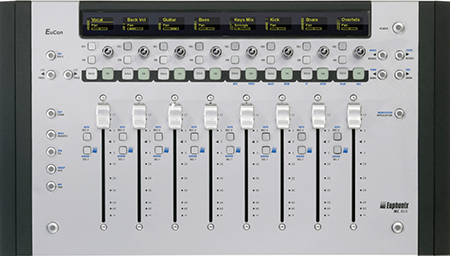
64With the Ipad, you don’t get the faders, but you can work in a some natural way.
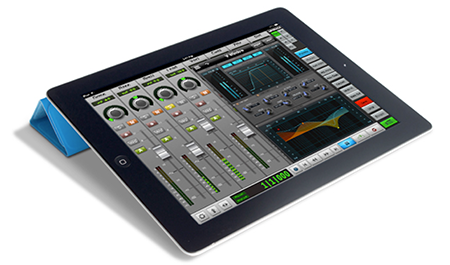
Shut your eyes
65Try to mix with eyes shut.

Productivity management
66One of the problems that we have in digital, is we typically don’t have time constraints. With digital, you can make stuff for weeks.
67What are you doing the next two days? You are probably able to say what you will do the next two days. But what are going to do the next two months? If you have two months to mix, you have to have a plan (in your head).
68One of the things I tell to my students is, “the reason why you came to the university, the reason why you paid money, one of them anyway, is: you pay money so you have deadlines”.
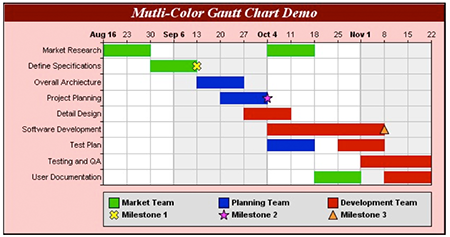
Digital - the analouge way
69The following figure shows an analogue mix that looks like in a digital workstation. It may look very wired, but I urge you to try it out. Every track gets an equalizer and a compressor, like you would on, say, an SSL. The rule is that you can’t change them – you have to use these two for compression and equalisation. On the right is the effect tack unit. I have a reverb, another reverb, another reverb and a delay – you can’t add anything, you have to use one of these plugins. And on the rightmost rack there are some other plug-ins, which are processors, just like on an analogue rack. The rule with these is that if you want to use any, you drag it to the relevant track; but you’re not allowed to add any plugins.
70So the whole Idea is that you must use the compressors and Eqs on each channel strip; you can only send to the auxes provided with the pre-loaded plugins, and you have a limited amount of extra plugins you can drag to the channels. It seems ridiculous to work this way – why would you limit your options in such way. Because these are the limitations analogue throws upon you and these limitations are good and make you more creative and productive. I have to admit, it’s very hard to work this way – I’m always tempted to add this plugin or another. But trying this out will give you a taste of what working in an analogue environment is like, and there are many great things to learn from this, despite the constraints. And I’m not claiming for a second that this is the best way to work, I just thing that anyone mixing in the digital domain has to have such experience and take whatever one thinks is good from it. Such thing can actually lead to better mixes.
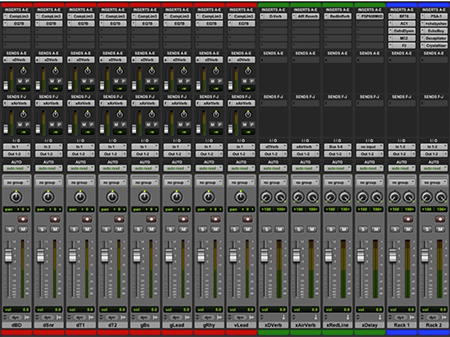
Notes
1 Awareness Test available here.


